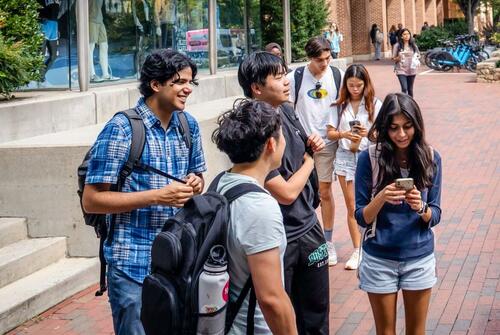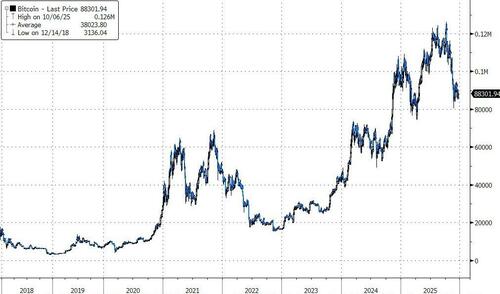Broken Britain
Authored by Andrew Ash via The Gatestone Institute,
There is a curious sense of minority entitlement which seems to have grown exponentially in recent years. It was absent when my father migrated from Egypt to England in the last century and met my mother. Although he considered himself a Muslim, he had a somewhat lackadaisical approach to his inherited faith – as did many Westernised Muslims of the time. He was proud of his faith, but he did not place being a Muslim at the forefront of his identity. Like many of his fellow émigrés, he wanted to escape the more oppressive religious aspects of his home country.
Occasionally he would visit one of England's seven mosques, which adequately serviced the needs of the fifty thousand Muslims at the time. The West was still largely ignorant of Islam. Britain's grasp of what it represented was minimal, to say the least, but my father did not move to England in the expectation that its denizens were fluent in Muslim culture or that there would be a mosque on every street. He did not feel that his human rights, by not being specifically catered to, were being violated. It was quite enough to find accommodation and work, rather than inventing grievances.
The thought of complaining, or being a victim, would have seemed incongruous to him -- presuming there had been anyone to complain to -- because, he said, at last he felt free.
He was not alone in thinking this way. As my family grew, my father made friends with other Muslim migrants and their families, who felt the same as he did.
Playing a "victim card" would have been deemed not only impolite and unappreciative, but woefully narcissistic. If any Muslim pressure groups or support networks had existed, he would most certainly have shunned them. Like many of his generation, he was far too proud to wish to appear needy. He even refused anything the fledgling benefits system had to offer, despite -- as our family grew -- being eligible for help. It would have been an affront to him to ask for assistance or even to have someone speak up on his behalf. He certainly did not want my (English) mother to wear a burka or a hijab.
Even their Muslim "nikah" marriage was for the sake of convenience. Like everyone else who takes up residence in a foreign country, he wanted, more than anything, simply to fit in and improve his lot in his new, adopted home.
In many of the Arab countries from which the friends of our family had migrated -- from Egypt, Jordan, Syria and Tunisia -- being deeply religious was a job. It was for scholars. He was not in the slightest bit offended by the predominantly Christian culture around him. There were no special interest advocates to stir the sediment and cause resentment -- from either England or the Middle East. Muslim immigrants of the time, like my father, just wanted to get along with as little disruption as possible.
Since then, a multiculturalism experiment has grown. Thanks largely to the introduction of separating people by identity politics, ethnic communities -- groups rather than individuals -- now find themselves encouraged to compete for recognition and reward. Not just amongst themselves; they have, perhaps unwittingly, found themselves pitted not only against one another, but also against the indigenous working-class families at the lower end of Britain's socio-economic scale. It is these dispossessed communities for whom I feel the most. It is they who bear the brunt of what they see as the unfair, discriminatory practices stacked up against them.
How could seeing Muslim immigrants receiving preferential treatment from the government that allows them to exploit the welfare system not act as a catalyst for division and anger? For example, polygamy might be legal in their home country, but this is most certainly not the custom in Britain. However, polygamous marriages are not only overlooked, they are rewarded by way of benefit payments to "wives" who may not even reside in the UK.
My father would have thought it was a bad joke if someone had suggested to him that 'halal' meat should be used in fast food outlets just to appease a Muslim minority. Yet this is exactly what has happened.
There are numerous examples of "controversial" planning decisions that regularly go the way of the Muslim applicant, such as providing "retrospective permission" for a "Muslim" cemetery.
For a local council to allow retrospective planning permission, as most householders in the UK will attest to, is no easy task. When it appears to have been sanctioned, and backdated by more than fifteen years -- as in Worcester Muslim cemetery -- head-scratching ensues. To then discover the permission was granted by a Muslim councillor whose first name is "Allah" -- the optics are, understandably, rather questionable.
There are so many other examples of "bad optics" -- the state's seemingly biased decision-making when British Muslims' interests are at stake. By reacting to them, one is quickly labelled "racist" or "xenophobic" -- exacerbating the problem. It is clear why my father was careful to avoid such conflicts. It does not make for a happy society when one exasperates one's neighbours in such a cavalier fashion. Neither should it take a genius to understand that apparent favouritism, be it in a family, the school playground, or in society as a whole, creates a breeding ground of resentment and discontent.
Either our successive governments have been bereft of geniuses, or there is something else at play. Certainly, if people wish to discuss the impact of the out-of-control immigration system that has led us to this point, the authorities do not seem to be even slightly interested. Instead, they are told that they are not entitled to play the victim card, so freely utilised by the minority groups. Their "white privilege" supposedly precludes them from sympathy.
Strange, then, that this huge swathe of allegedly "privileged" people continues to become increasingly disadvantaged -- deprivileged -- as the ever-expanding Muslim communities of Britain prosper. Not only do they have their religious needs catered to -- as in the above examples -- but also by seeming to receive special treatment regarding the welfare system, as well as special protection by the expansion of hate crime laws.
British Muslims, along with a variety of other minorities, have come to realise that there is currency in claiming victimhood. There are rewards to be found in appearing helpless, a label which my father -- and his generation of proud Muslim migrants -- would have found demeaning and insulting, at best.
Tyler Durden Fri, 12/19/2025 - 02:00

 Ghislaine Maxwell, longtime associate of accused sex trafficker Jeffrey Epstein, speaks at a news conference at the United Nations in New York on June 25, 2013. UNTV via Reuters
Ghislaine Maxwell, longtime associate of accused sex trafficker Jeffrey Epstein, speaks at a news conference at the United Nations in New York on June 25, 2013. UNTV via Reuters Acting U.S. Attorney for the Southern District of New York Audrey Strauss announces charges against Ghislaine Maxwell in New York on July 2, 2020. Johannes Eisele/AFP via Getty Images
Acting U.S. Attorney for the Southern District of New York Audrey Strauss announces charges against Ghislaine Maxwell in New York on July 2, 2020. Johannes Eisele/AFP via Getty Images





















Recent comments